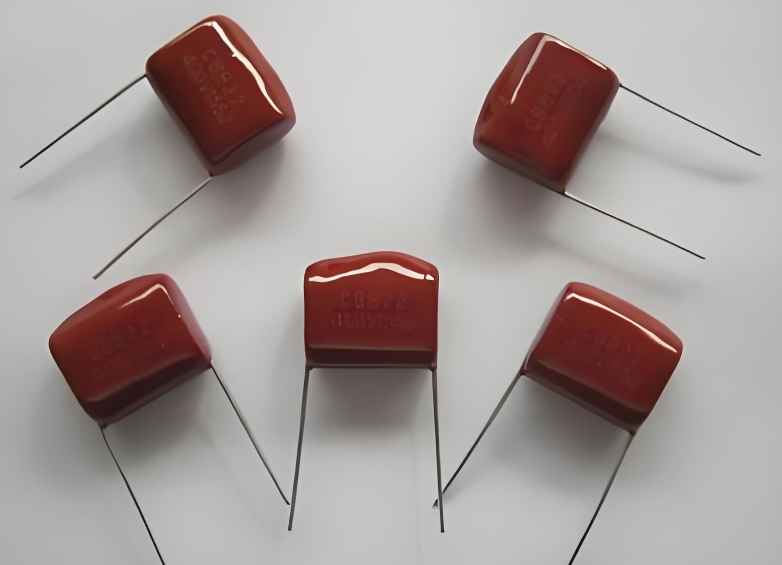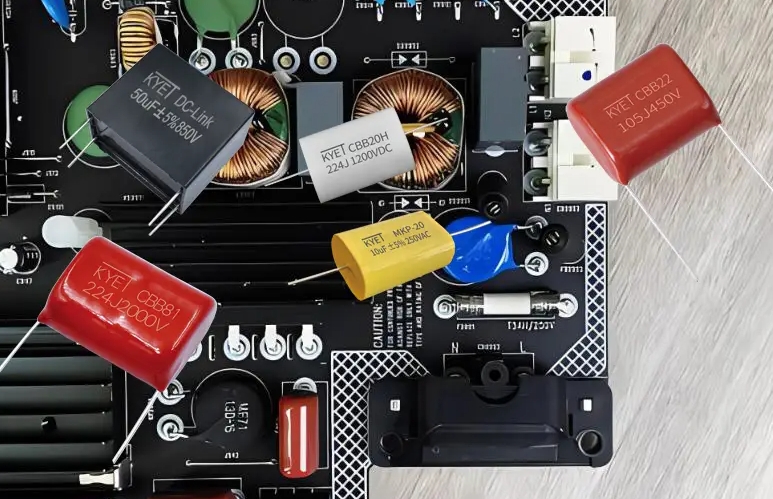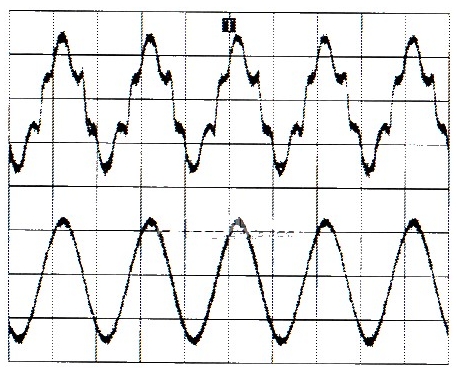One article to understand the film capacitor common problems
2024-05-15 16:30:31 33
A film capacitor, also known as a metallized film capacitor, is a capacitor that uses a polymer film as a dielectric. The core feature of this type of capacitor is that its internal electrode is composed of an extremely thin metal layer, which is usually deposited directly on the surface of the film through vacuum evaporation technology to form a metallized layer. This design greatly reduces the thickness of the electrode, so that the film capacitor can achieve a high capacitance in a small volume, which is suitable for applications requiring miniaturization and high capacitance density.

The structure of film capacitors is generally divided into two types: winding type and laminated type. The winding type is to overlap the film with a metalized layer from both ends and wind it into a cylinder, and then seal it into the shell; The laminated type is to alternately superimpose the multi-layer film and the metallized layer, and then the whole package. Because the winding structure is easy to produce, it is more common in practical applications.
Working principle of thin film capacitor
The core of the film capacitor is its thin insulating material (medium), common PET, PP, PEN and so on. The working principle is based on electrostatics, and when an insulating film is sandwiched between two metal foils (electrodes) and a voltage is applied, opposite charges accumulate on the metal foil, thereby storing electrical energy. Its outstanding characteristics are high temperature stability, self-healing (that is, the ability to automatically restore insulation in the case of a slight short circuit) and excellent high-frequency performance, which makes film capacitors particularly important in precision electronic devices.

Basic knowledge and technical parameters of thin film capacitors
Understanding the basic structure of film capacitors, such as metallized film lamination and packaging, is a prerequisite for mastering their working principle. Technical parameters such as withstand voltage (rated voltage), capacitance (capacitance), loss Angle tangent (reflecting the degree of energy loss), etc., are the key indicators to evaluate the performance of capacitors. Compared with aluminum electrolytic capacitors, thin film capacitors usually have lower ESR (equivalent series resistance) and higher stability, but the cost is relatively high; Compared with ceramic capacitors, thin film capacitors are usually better in high frequency performance, but they are larger in volume.
Types and application fields of thin film capacitors
species
Classification by dielectric material:
-
Polypropylene capacitors (PP capacitors) : with high stability, low loss, high voltage characteristics, suitable for high frequency, high voltage applications.
-
Polyester capacitor (Mylar capacitor) : low cost, good stability, suitable for general signal coupling, filtering.
-
Polystyrene capacitor (PS capacitor) : has good frequency characteristics, often used in audio equipment.
-
Polycarbonate capacitor: Good high temperature resistance, suitable for high temperature environment applications.
-
N-type capacitor (PEN, polyvinyl naphthalate) : between PP and PET, good overall performance.

Classification by wire end:
-
Dc film capacitors: for direct current circuits, divided into general purpose, suppression of electromagnetic interference, pulse and precision types.
-
Ac film capacitors: Used in AC circuits, commonly used in motor starting, power factor correction, etc.
Application field
Thin film capacitors are widely used in areas with high capacitor performance requirements, such as analog signal processing, power supply filtering, bypass and coupling in high-frequency circuits, power supply noise suppression, and as key components in electronics, home appliances, communications, electric power, hybrid vehicles, renewable energy (such as wind, solar) and other industries.
Selection guide for film capacitors
Selection error correction
When choosing film capacitors, it is not wise to blindly pursue large capacity. The appropriate capacity should be selected according to the specific application requirements, while considering the voltage level of the capacitor, capacity requirements, size limitations, operating temperature range, frequency response and other factors. For brand selection, consider well-known manufacturers such as KEMET and TDK, and evaluate the cost performance ratio to ensure that both performance requirements are met and economy is affordable. The diversity of brands and types means that there is no "one-size-fits-all" capacitor, and the most suitable model should be selected for the specific application scenario.
Common faults and solutions of film capacitors
Although thin film capacitors are known for their high stability and long life, they may still encounter some failures in actual use. Here are some common failures and their corresponding solutions:
1. Improper wire connection: When multiple thin film capacitors are used in parallel, incorrect connection may cause the capacitor to fail to work properly.
Solution: Check and make sure all capacitors are connected in the correct way, and re-solder or use dedicated connectors if necessary.
2, beyond the specified voltage range: the applied voltage exceeds the rated value will cause capacitor damage.
Solution: Verify the circuit design to ensure that the operating voltage is within the rated voltage range of the capacitor, and replace the capacitor with a higher rated voltage if necessary.
3, improper current selection: Inappropriate current selection will affect the capacitor performance, especially the DC maintenance and harmonic vibration parts.
Solution: Recalculate the circuit current requirements and select the appropriate capacitor model to withstand the expected maximum current.
4, leakage fault: the insulation performance between the two capacitor plates decreases, resulting in an increase in leakage resistance.
Solution: Detect the leakage of the capacitor, if it exceeds the allowed range, it is necessary to replace the new capacitor.
5, breakdown fault: the capacitor internal short circuit, loss of straightening and filtering function.
Solution: Use a multimeter to check whether the capacitor is broken down, and once confirmed, replace it immediately.
6, the temperature is too high: long-term work in a high temperature environment, may reduce the capacitor life or lead to immediate failure.
Solution: Improve heat dissipation conditions, use high temperature resistant capacitors, or add heat sinks.
7, shell expansion or oil leakage: indicates abnormal internal pressure or seal failure.
Solution: Deactivate and replace the capacitor immediately to prevent further damage or safety risks.
8, casing rupture, flashover and spark: trauma or internal failure may cause this phenomenon.
Solution: Check the circuit for overvoltage or short circuit problems and replace the damaged capacitor.
9, abnormal sound: a sign of internal mechanical or electrical failure.
Solution: Discontinue use and check the capacitor to find the source of the sound and replace it if necessary.
To prevent these failures, regular maintenance is recommended, including checking the appearance of the capacitor, monitoring the operating temperature and voltage, and following the correct installation and use specifications. When handling faulty capacitors, it is important to take appropriate safety measures such as thorough discharge and wearing personal protective equipment.
Film capacitor market and industry dynamics
The global film capacitor market continues to grow, driven by new energy, automotive electronics, and 5G communications. Technological innovation focuses on the development of new thin film materials, such as polymers with high dielectric constants, to improve energy density and operating temperature range.
Alternatives and comparison of thin film capacitors
Compared with aluminum electrolytic capacitors, thin film capacitors have longer life and better high-frequency performance. Ceramic capacitors may have more advantages in volume and cost, but their high-frequency performance is not as good as that of thin film capacitors. Weigh performance indicators based on specific application scenarios.
Test and maintenance of thin film capacitors
Regular capacity testing, leakage current testing and voltage resistance testing are necessary maintenance measures. Maintaining appropriate ambient temperature and humidity and avoiding excessive vibration can effectively extend the life of capacitors.
Problems often arise when thin film capacitors are used
Improper selection of current in the range
The overcurrent problem of thin film capacitors is often caused by improper current selection, which will not only cause the capacitor to heat up, shorten the life, but also cause an explosion in serious cases. The key to solving this problem is to precisely match the current bearing capacity of the capacitor with the circuit requirements. The user should carefully calculate the maximum working current of the circuit, and refer to the data manual of the capacitor, select the product whose rated current is greater than the actual maximum current value. In addition, it is necessary to consider the transient current in the circuit, and safety can be further enhanced by paralleling appropriate fuses or using circuit designs with overcurrent protection.
The cable is improperly connected
When multiple thin film capacitors are used in parallel, a reasonable connection mode is very important. Uneven temperature rise or current distribution can cause some capacitors to fail prematurely. It is recommended to use the star-shaped or balanced parallel mode, and ensure that the length and cross-sectional area of the connecting wires are the same to reduce the difference in resistance and ensure the balanced current distribution. At the same time, the use of high-quality welding technology and insulation materials can effectively reduce the thermal and electrical stress at the connection site.

Voltage beyond the specified range
Voltage overrun is a common cause of breakdown of thin film capacitors. Designers should strictly abide by the rated voltage value of the capacitor, consider the peak voltage that may occur in the circuit, and leave enough safety margin. In the case of uncertainty, choosing a capacitor with a higher voltage rating is a conservative but effective strategy. In addition, the use of a voltage clamp device (such as a Zener diode) or a voltage regulator circuit can provide additional protection for the capacitor.
Fault causes and countermeasures of thin film capacitors
The ambient temperature is high
In high temperature environment, the performance of thin film capacitors will be significantly reduced, and the life will be shortened. Improving heat dissipation conditions, such as increasing heat sinks, optimizing the layout to promote air circulation, and selecting capacitor types with better high temperature performance are effective countermeasures.
Improper selection of working current and voltage
In addition to the current selection mentioned above, the voltage selection is equally important. Correct assessment of the system voltage fluctuation range, avoiding long working conditions close to the rated voltage, can effectively reduce the risk of breakdown.
Harmonic current effect

Harmonic currents can increase capacitance load and cause overload. Using filters to suppress harmonics, or considering the use of capacitors designed to handle harmonics during the design phase, are effective means of mitigating the effects of harmonics.
Characteristics and application scenarios of thin film capacitors
Film capacitors of different materials (such as polypropylene, polyester) and structures have their own advantages in terms of frequency response and temperature stability. For example, polypropylene capacitors are suitable for high-frequency filtering and bypass applications, while polyester capacitors are commonly used for audio signal processing. Understanding these features will help you accurately match your application's needs.












